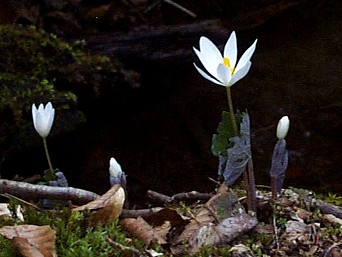![]()
![]()
![]()
Sanguinaria canadensis - Indian Paint. Tetterwort. Red Pucoon. Red Root. Paucon. Coon Root. Snakebite. Sweet Slumber.
![]()
Use the 'back' button on your browser to return, if necessary.
|
|
DESCRIPTION: FLOWERS: HABITAT:
| ||
|
OTHER INFORMATION: This flower usually lasts only a short while. It is an indicator species to the Birch-Maple-Basswood hardwood forests of North America. It makes its way into NC only in the mountains. Its flower is not insect-specific (such as turtleheads) probably because the insect activity is low so early in the year. You'll see a groggy bumblebee or two visiting if you wait long enough.
The known ingredients of the root are the alkaloids Sanguinarine, Chelerythrine, Protopine and B. homochelidonine. Protopine, which is also found in opium, is one of the most widely diffused of the opium alkaloids. The rhizome also contains red resin and an abundance of starch. The root (or juice) of bloodroot is considered toxic, and this is a poison, kiddies. Overdose symptoms include burning in the stomach, intense thirst, vomiting, faintness, vertigo, intense prostration with dimness of eyesight. However the native Americans had many uses for this plant, though i suspect in minute doses and in conjunction with other herbs. The ailments it helped with was rheumatism, asthmas, bronchitis, lung ailments laryngitis and fevers. Used as an emetic. It was also reportedly used as a skin-dye by them. Used commercially as a plaque-inhibiting agent in toothpaste, mouthwashes and rinses. Somewhere i read that the juice applied to warts will remove them. With bright blood-red warts, i'm sure you'll want them removed! Additionally, the root has long been used by the native Americans as a dye for their bodies and clothes and has been used successfully by American and French dyers. 
| |||
OTHER OBSERVATIONS:
Bloodroot along the BRP can be found around milemarker 294.
OFFSITE INFORMATION:
Medical uses can be found at the Modern Herbal.
NC Natural has more information and another photo of Bloodroot.
Wildflowers of Scott County has another photo.
Of course, Stein's Herbarium would have a picture of this pretty flower.
The Alternative Nature homepage has a good photo without the flower and some medicinal uses.
MotherNature.com has some more information on this plant.
![]()